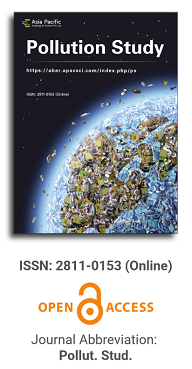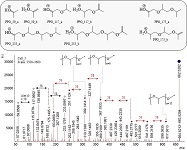
Asia Pacific Academy of Science Pte. Ltd. (APACSCI) specializes in international journal publishing. APACSCI adopts the open access publishing model and provides an important communication bridge for academic groups whose interest fields include engineering, technology, medicine, computer, mathematics, agriculture and forestry, and environment.

The (partial) replacement of synthetic polymers with bioplastics is due to increased production of conventional packaging plastics causing for severe environmental pollution with plastics waste. The bioplastics, however, represent complex mixtures of known and unknown (bio)polymers, fillers, plasticizers, stabilizers, flame retardant, pigments, antioxidants, hydrophobic polymers such as poly(lactic acid), polyethylene, polyesters, glycol, or poly(butylene succinate), and little is known of their chemical safety for both the environment and the human health. Polymerization reactions of bioplastics can produce no intentionally added chemicals to the bulk material, which could be toxic, as well. When polymers are used to food packing, then the latter chemicals could also migrate from the polymer to food. This fact compromises the safety for consumers, as well. The scarce data on chemical safety of bioplastics makes a gap in knowledge of their toxicity to humans and environment. Thus, development of exact analytical protocols for determining chemicals of bioplastics in environmental and food samples as well as packing polymers can only provide warrant for reliable conclusive evidence of their safety for both the human health and the environment. The task is compulsory according to legislation Directives valid to environmental protection, food control, and assessment of the risk to human health. The quantitative and structural determination of analytes is primary research task of analysis of polymers. The methods of mass spectrometry are fruitfully used for these purposes. Methodological development of exact analytical mass spectrometric tools for reliable structural analysis of bioplastics only guarantees their safety, efficacy, and quality to both humans and environment. This study, first, highlights innovative stochastic dynamics equations processing exactly mass spectrometric measurands and, thus, producing exact analyte quantification and 3D molecular and electronic structural analyses. There are determined synthetic polymers such as poly(ethylenglycol), poly(propylene glycol), and polyisoprene as well as biopolymers in bags for foodstuffs made from renewable cellulose and starch, and containing, in total within the 20,416–17,495 chemicals per sample of the composite biopolymers. Advantages of complementary employment in mass spectrometric methods and Fourier transform infrared spectroscopy is highlighted. The study utilizes ultra-high resolution electrospray ionization mass spectrometric and Fourier transform infrared spectroscopic data on biodegradable plastics bags for foodstuffs; high accuracy quantum chemical static methods, molecular dynamics; and chemometrics. There is achieved method performance |r| = 0.99981 determining poly(propylene glycol) in bag for foodstuff containing 20,416 species and using stochastic dynamics mass spectrometric formulas. The results highlight their great capability and applicability to the analytical science as well as relevance to both the fundamental research and to the industry.
Volume 3, Issue 1 reviews key advancements in pollution research, including case studies on air pollution and the use of microorganisms for soil remediation. These studies expand the boundaries of pollution control technologies and highlight the complex connections between the environment, economy, and health. Reading this issue will inspire scholars to explore future research directions.
Issue release: 31 December 2022
The exploitation of petroleum assets fuels economic and societal progress, but it also leads to extensive contamination of land with oil and petrochemicals, which increasingly threatens the environmental integrity of these areas. Bioremediation has emerged as a favored approach for addressing this issue due to its environmentally benign nature and absence of secondary pollution. This discourse encapsulates the latest advancements in bioremediation strategies, particularly those involving microbial and phytoremediation techniques for tackling petroleum and petrochemical contamination. It also examines the constraints of current bioremediation practices and envisions future research directions. The objective is to enhance the efficacy of bioremediation for contaminated sites and to establish a scientific foundation that will support the evolution and comprehensive application of bioremediation technologies.
Issue release: 31 December 2022
Issue release: 31 December 2022
Issue release: 31 December 2022
Objective: To examine the correlation between the volume of adult asthma patients seeking outpatient care and air pollution levels at a hospital in Hefei. Methods: Data on the number of asthma outpatients at a Hefei hospital from 2014 to 2020 were gathered, along with corresponding air pollution and meteorological data for the same timeframe. The R statistical software was employed to construct a generalized additive model to assess the lagged effects of air pollution on asthma outpatient numbers. Results: The hospital recorded a total of 7220 asthma outpatients during the study period, with 3104 males and 4116 females, 3798 in the warm season and 3422 in the cold season. The single pollutant model revealed that a 10% increase in SO2 concentration μg/m3 was associated with a 0.74% increase in asthma risk, with the strongest effect observed at lag2. NO2 was found to increase asthma risk by 0.31%, with the most significant impact at lag0. The two-pollutant model indicated that the effect of SO2 combined with NO2 diminished when SO2 was also combined with CO, O3, PM10, and PM2, with an increased post-5 lag effect. Conversely, the effect of NO2 combined with SO2 decreased when NO2 was also combined with CO, PM10, and PM2, with an increased post-5 lag effect. Stratified analysis by season showed that NO2's impact on asthma was greatest at lag0 during the cold season, while SO2's effect was more pronounced in the cold season than in the warm season, with the highest impact at lag2. Gender stratification analysis revealed that the effects of SO2 and NO2 were greater in men than in women. Conclusion: Between 2014 and 2020, an increase in SO2 and NO2 concentrations in Hefei was positively associated with the risk of asthma among outpatients at the hospital, with a noticeable lag effect. This finding underscores the importance of developing targeted preventive strategies to mitigate asthma occurrences and exacerbations.
Issue release: 31 December 2022
In the major grain production regions of China, agricultural non-point source pollution and the eutrophication of adjacent surface waters due to the excessive use of chemical fertilizers continue to be significant issues. To address the irrational traditional fertilization practices of farmers and to mitigate agricultural non-point source pollution, a fertilization reduction project was initiated in Jiangshan City. This project aimed to investigate the impact of reducing fertilizer application by 10% to 30% on the yield of Yongyou 15 rice variety and the loss of nutrients (total nitrogen, total phosphorus, and total potassium) in the surface runoff from paddy fields, relative to the farmers' standard fertilization practices. The findings indicated that reducing the conventional fertilizer dosage by 10% to 20% did not lead to a significant decrease in rice yield, with the yield being highest at a 10% reduction. Following fertilization, the nutrient concentration in the paddy field drainage rapidly reached a peak within one hour, after which nitrogen, phosphorus, and potassium concentrations decreased sharply by 25.9% to 66.0%, 70.1% to 88.3%, and 25.0% to 52.5%, respectively, within 24 hours. Subsequently, all nutrient levels continued to decline gradually until the end of the experiment. This suggests that the risk period for nutrient loss, which also corresponds to a high-risk period for non-point source pollution, occurs within a few days after fertilization, particularly if the paddy field is drained due to heavy rain or artificial means. The reduction in chemical fertilizer significantly influenced the nutrient content in the paddy field drainage. One hour after fertilization, reducing the conventional fertilization rate by 10% to 30% resulted in decreases in the concentrations of total nitrogen, total phosphorus, and total potassium in the drainage by 3.7% to 68.2%, 26.3% to 64.8%, and 5.8% to 57.5%, respectively. This approach holds significant potential for enhancing economic benefits and safeguarding the ecological environment in rice cultivation.
Issue release: 31 December 2022
Petroleum hydrocarbons represent a challenging global pollution issue, with their degradation presenting a significant for environmental scientists. Microbial immobilization technology (MIT) offers a promising solution due to its efficiency, stability, cost-effectiveness, and environmental benefits, making it a highly promising approach for soil cleanup. Over recent years, the research on using MIT to remediate petroleum hydrocarbon-contaminated soil has surged in popularity. This technology has emerged as a potent means to enhance the microbial breakdown of petroleum hydrocarbons in soil. The paper reviews the advancements in microbial immobilization technology, outlines the distinct attributes of carrier materials, microorganisms, immobilization techniques, and factors affecting the process, along with their influence on the immobilization outcome. It also discusses the current state and future directions of this technology in the remediation of petroleum hydrocarbon-contaminated soil.
Issue release: 31 December 2022
This research utilized a bioreactor approach for the remediation of petroleum-contaminated soil, enhancing the process with chemical oxidation to investigate its efficacy. Additionally, the study employed the BIOLOG ECO board and high-throughput sequencing techniques to delve into the mechanisms behind the microbial community’s response. The findings indicated that after 240 days of bioremediation, the treatments involving standard bioremediation (NP) and bioremediation enhanced with oxidants (NP_O) reduced the soil’s total petroleum hydrocarbons from an initial 30,649 mg·g−1 to 5889 mg·g−1 and 2351 mg·g−1, respectively. The soil concentration of petroleum hydrocarbons following oxidation-enhanced bioremediation was found to be below the national risk control threshold (GB 36600-2018). Further analysis using BIOLOG ECO micropore tests and high-throughput sequencing revealed that microbial activity in the oxidant-treated soil was promptly rejuvenated. The study identified potential bacterial markers for petroleum hydrocarbon degradation in the treatment with chemical oxidation-enhanced bioremediation, including Genus Microbacterium, paracoccus, pseudomonas, stenotrophomonas, and Porticoccaceae_C1.B045.
Issue release: 31 December 2022
A graphite electrode was placed at each end of the soil contaminated with oil, and a direct current (DC) voltage of 24 V was applied to decrease the electrical potential across the soil between the electrodes to 1 V/cm. The study examined the impact of the combined electrokinetic and microbial remediation method on various soil parameters such as pH, soil temperature, organic carbon content, and the availability of nitrogen, phosphorus, and potassium in petroleum-contaminated soil. The findings revealed that after the combined treatment, the degradation rate of the simulated soil contaminated with 2% petroleum reached an optimal level of 67.5%. Additionally, the availability of nitrogen, phosphorus, and potassium increased by factors of 1.5, 1.4, and 1.2, respectively. The integration of electric remediation also demonstrated its ability to maintain the soil's pH and temperature within a stable range, thus creating a favorable environment for microbial activity and enhancing the rate of oil degradation.
.jpg)
Beijing University of Technology, China




 Open Access
Open Access